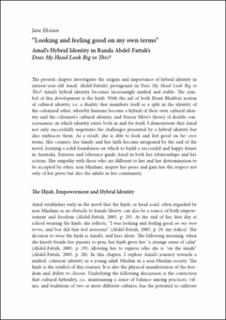“Looking and feeling good on my own terms”: Amal’s hybrid identity in Randa Abdel-Fattah’s Does My Head Look Big in This?
Chapter, Peer reviewed
Published version
Permanent lenke
https://hdl.handle.net/11250/2976562Utgivelsesdato
2021Metadata
Vis full innførselSamlinger
Originalversjon
Björk, E. L., Eschenbach, J.& Wagner, J.M. (Ed.). (2021). Women and Fairness: Navigating an Unfair World. Waxmann. 10.31244/9783830993650Sammendrag
The present chapter investigates the origins and importance of hybrid identity in sixteen-year-old Amal, Abdel-Fattah’s protagonist in Does My Head Look Big in Th is? Amal’s hybrid identity becomes increasingly unifi ed and stable. Th e symbol of this development is the hijab. With the aid of both Homi Bhabba’s notion of cultural identity, i.e. a duality that manifests itself as a split in the identity of the colonized other, whereby humans become a hybrid of their own cultural identity and the colonizer’s cultural identity, and Nassar Meer’s theory of double consciousness, in which identity exists both in and for itself, I demonstrate that Amal not only successfully negotiates the challenges presented by a hybrid identity but also embraces them. As a result, she is able to look and feel good on her own terms. Her country, her family and her faith become integrated by the end of the novel, forming a solid foundation on which to build a successful and happy future in Australia. Fairness and tolerance guide Amal in both her relationships and her actions. Her empathy with those who are diff erent to her and her determination to be accepted by other, non-Muslims, inspire her peers and gain her the respect not only of her peers but also the adults in her community.

